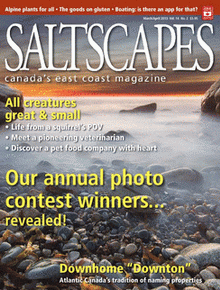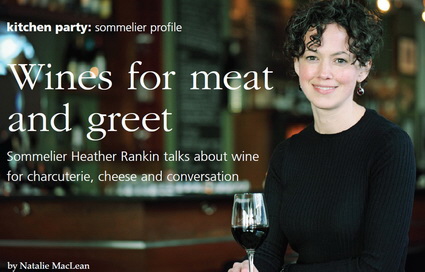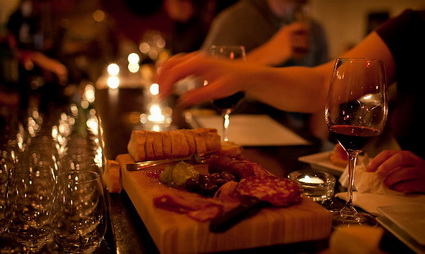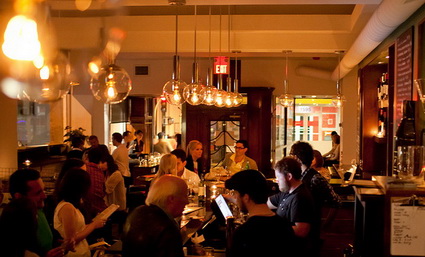Heather Rankin is co-owner (with her brother, Christian Rankin) of Obladee Wine Bar in Halifax. The oldest of five kids, she was born and lived in the Halifax area until she was a young teen, when her parents moved to the fishing town of Port au Choix on the Northern Peninsula of Newfoundland.
After studying at St Francis Xavier University in Antigonish, NS, and at Carleton in Ottawa, she spent 15 years working in web development in places like New York and London, England.
“It was when I was in London that I decided it was time to move back to the East Coast,” she says. “I didn’t want to just work in an office somewhere—I wanted to open something that was my own, and I’d always really loved food and wine.”
Her brother expressed an interest in joining her in that venture, and Obladee opened in 2010. This year, it took the silver award in the New Business of the Year category from the Halifax Chamber of Commerce.
“We like to call it ‘The people’s wine bar,’” says Rankin, “so when people tell us they love it—that’s really good.”
Was wine a part of your family’s life and meals?
Not really. Family meals were very important, but wine never really made an appearance. For one thing, wine was fairly hard to come by in rural Newfoundland and it wasn’t part of the culture.
What was your first memorable wine experience?
I was in my early 20s planning a South-American-themed dinner party and noticed a Chilean wine advertised in Vanity Fair. I took the magazine to a wine shop and bought it, feeling very sophisticated and grown up. It was the first time that I really enjoyed wine with food.
How did you get involved with wine professionally?
I’d spent 15 years in the technology industry and wanted a total career change. I also wanted to move back to the east coast and figured that doing so would be the best time to make a full transition into the wine business.
Over dinner one night while my brother was visiting me in London, Ontario, we discussed ideas for opening a wine bar in Halifax and that was that. I started studying wine in London and then continued with the Canadian Association of Professional Sommeliers (CAPS) in Halifax to earn my professional sommelier certificate.
Did you consider other occupations?
I enjoyed the detail-oriented aspect of programming, and that it’s results-based, not theoretical. If someday I grow tired of the wine profession, I’d like to try my hand at writing.
What are you passionate about aside from wine?
I love creating and being active. I adore food and my family.
Did you have a mentor or a role model in the wine world?
When I decided to open a wine bar in Halifax, I got in touch with Gerard Menan, the long-time manager of Gordon’s Wine Bar in London. I always liked Gordon’s for its laid back approach to wine and its history—I wanted to learn all I could about running a place like that.
Gerard was generous with his time, insights, cautions. He’s French, so he didn’t mince words and was very honest and direct with me. I appreciated that. After moving to Halifax, I connected with Peter Smit, the owner of the super-charming happinez wine bar in Saint John, New Brunswick. This bar also epitomized what I wanted Obladee to be: a neighbourhood place that focused on people.
How do you know customers’ level of comfort with wine?
We’re fortunate to get all types at Obladee, from the novice wine drinker to the expert. We do our best to accommodate them all. I don’t have any real tricks for pinpointing a customer’s comfort level, but it’s usually fairly obvious right away, whether from the look on their face to the questions they ask. I generally let the customer do most of the talking and step in only where they need me to. The worst thing you can do is assume the customer knows less than you do.
How is wine used to differentiate the restaurant?
I think a well thought-out wine list that changes regularly, is priced appropriately and that offers a number of options by the glass from various regions and styles is what sets you apart. Gone are the days of the annually printed wine list that is mostly by the bottle and leans too heavily toward one particular region or style. If the restaurant is serving outstanding food, it should have an outstanding wine list.
Describe your wine list.
We’re a small bar with about 90 labels by the bottle and more than 30 by the glass. We carry about ten Nova Scotia wines at any given time. As far as rare wines go, we keep an eye out for oddball stuff that turns up every now and then in our liquor stores, like Greco di Tufo or Lebanese reds, which I happen to be fond of.
We don’t carry many trophy wines either. Tenuta San Guido Bolgheri Sassicaia is probably our most expensive bottle at $260. Our cellar is fairly new so we don’t have too many old and dusties yet—our oldest bottle is a 2001 Rioja Gran Reserva … still a spring chicken!
What’s your opinion of Nova Scotian wines?
Nova Scotia is capable of making excellent, world-class wines. We’re relatively new at the winemaking craft and still learning, but importantly, there is a commitment to quality and on suiting grape to place.
My opinion is that the white and sparkling wines are where our abilities really shine. We are a cool-climate region, with soil conditions suited to growing and producing a crisp, aromatic style of wine that has become a signature style for the province. Our conditions are ideal for traditional method sparkling wine, producing grapes with just the right sugar and acid levels.
Name your three favourite Nova Scotian wines.
The 2010 Gaspereau Muscat is so easy to love. This I give to people who are unsure about, or just starting to try Nova Scotian wines—it pleases just about everyone. It’s hugely aromatic with grapefruit, lychee, blossom and melon aromas. It’s also dry on the palate with great purity of fruit and balanced acid.
The 2011 Blomidon Rose is a Nova Scotian take on a Provençal style. The nose is packed with notes of strawberry, herb, rose petal and lychee. The palate is off-dry, but lean and minerally with lively fruit and bracing acidity. Pair it with a starter of smoked salmon with soft, creamy chevre on toasted baguette.
The incredibly lively 2007 L’Acadie Blanc Prestige Brut offers crisp green apple and lemon pie flavours. Its busy, zippy bubbles and arresting acidity are perfect with oysters.
What are your tips for pairing wine with charcuterie?
I think the biggest misconception is that all charcuterie is the same and goes best with beaujolais. Beaujolais is a brilliant food wine for its fruitiness and acidity and it often pairs beautifully with cured meats, but it isn’t the only option.
Heavier, richer charcuterie can handle a heftier wine, such as a Canadian cabernet franc, a muscular pinot noir like Burgundy’s Pommard or rustic Italian reds like barbera d’Alba. As well, the high salt and fat in charcuterie often makes brilliant partners with fortified, dessert or late-harvest wines. The possibilities are quite endless.
photo: G. Langille
Name some terrific pairings for specific types of charcuterie.
Try sherry with hams such as mangalica jamon or Serrano; sauternes with duck liver paté; or merlot with bresaola, an air-dried, salted beef. The toughest charcuterie to pair with wine are the spicier items, such as sausages like chorizo or pepper beisser. Spicy and hot foods numb our taste buds a little, making the fruit flavour of wine seem muted and the alcohol impression higher. My personal choice in these cases would be beer.
Your tips for pairings cheese and wine?
The biggest challenge with pairing wine and cheese is a cheese’s tendency to coat the tongue and generally “hang around” in your mouth too long. If you’ve got a film on your tongue, you’re not going to be tasting much of anything. With this richness, you need a wine to wash away the fatty film, rather than add to it, so a fresh, fruity wine with good acidity such as pinot noir, riesling, albarino or merlot. And as with all food and wine pairings it’s always wise to match like-with-like and strength-with-strength.
Some specific cheese and wine pairings?
I’ll stick with the classics: goat cheese with sauvignon blanc, roquefort with the sweet bordeaux wine sauternes, camembert with champagne, manchego with tempranillo. It also depends on other flavour factors, such as the cheese’s age (and therefore, pungency), its rind and texture.
What if a customer orders a wine that’s inappropriate for the meal?
This may be controversial, but I’m not sure any wine is truly inappropriate for a meal. People have different goals for enjoying wine and food together. Some diners want the food to stand out and keep the wine in the background, others want the wine to shine, and yes, many probably want the two in harmony. But I think it’s important to find out what the customer’s goals are. A few times I’ve suggested a wine for what I know to be a solid pairing only to find out the guests didn’t really like the wine. If I had been reading them properly, I might have gone with something I knew they’d find more palatable.
What’s the strangest wine and food pairing you’ve tried?
I tried a cupcake made of truffles and chocolate with a pinot noir once. I don’t recommend it.
What wine would you pair with a filet of porcupine?
A prickly, zingy sauvignon blanc? I really have no idea. I’ve never tried porcupine!
Which wine would you pair with Kraft Mac & Cheese?
I would not.
Who’s the most famous person who’s dined in your restaurant?
The British rock guitarist Jeff Beck and his band came in one night and stayed until close. I guess they really liked it because they came back the following night and brought their crew. That was pretty fun, they were a great group.
What is the toughest challenge of your job?
The toughest challenge is finding quality for price. As price goes up, so usually does quality. But the challenge is in finding those gem bottles, those great wines that are inexpensive and offer killer value.
What bottles would be in your dream cellar?
I love Champagne, so it would be full of that. I also love white and red burgundy, France; premium sauvignon blanc from the Western Cape, South Africa; wines from Priorat, Spain; as well as the Margaret River, Australia. I don’t really believe in collecting wine; I prefer to drink it. So all of the wines in my cellar would be called upon very regularly – unless of course they were aging, and then I would let them sleep for a bit.
What’s popular right now for wine regions, grapes and wineries?
The Languedoc region in southern France is really popular at the moment. It’s down-sized quite a bit and shifted from being a high-volume, “glut” wine to one which is focused on quality, terroir expression and value.
As far as grapes go, gamay is really hitting its stride. Beaujolais, and particularly cru Beaujolais, has upped its game and the wines, when made properly, can be really terrific. People are seeing it as a an affordable and acceptable alternative to its more expensive neighbour in Burgundy, pinot noir.
Wineries to watch for are small, precision-oriented outfits using a natural, hands-off approach to winemaking. There are many in this category, but a hot one at the moment is Tawse Winery in Niagara.
To which wine region have you travelled recently?
I was recently in B.C.’s Okanagan Valley, one of the most beautiful wine regions I’ve been to. A cluster of small, hidden-away wineries are making honest and pure wines that reflect the land. There is a great enthusiasm and spirit there with a real integrity in the winemaking. There seemed to be a genuine, collaborative community as well.
If you could share a great bottle of wine with anyone, who would it be?
Leonard Cohen. I love his music and storytelling. He’s so cool, too.
Have you ever broken or dropped a bottle?
I once dropped an entire bottle of wine and two glasses on a couple out celebrating their anniversary. Thankfully, it was white, a Torrontes from Argentina. The couple was good natured. Their tab was on me.
When you dive into the fridge for that sinful indulgence, what is it?
If I’m indulging, it’s probably on salt and vinegar chips with bubbly, maybe with a hint of sweetness, like Nova Scotia’s Benjamin Bridge Nova 7.
You’ve worked late and missed dinner with your partner. You grab a bottle of wine and his favourite dessert. What are you bringing and what happens next?
My partner is an easy one—he loves dessert, especially lemon pie. So I’d pick that up and a bottle of Benjamin Bridge Brut Reserve. This sparkling wine has a delightful lemon curd/lemon pie quality that would work well with the dessert, and the wine’s prominent acidity would match nicely the tang of the lemon. The bubbles would cheer us both up. All would be forgiven.
What special bottle is in your personal wine cellar at home right now?
Any wines I “cellar” I’m saving because they have a sentimental attachment or, I’m waiting for the wines to reach peak, or the wine is particularly hard to find. For example, I love Madiran Tannat and I have a special bottle of Chateau Montus that was given to me by a friend a few years ago. I plan to open it when the person is back in town next month.
What’s your best tip to diners in a restaurant when they’re choosing wine?
If you’re not sure where to start on a wine list, try to recall a wine you really enjoyed: what was the colour, the weight, the region? Then try to find some commonalities on the wine list.
For example, “I can’t remember the grape or blend, but I know it was red from Spain, and it wasn’t too heavy.” This gives you a great starting point for either perusing the list on your own or discussing options with the server. Once you’ve zeroed in on a wine, you can start thinking about the food to match.
What is your favourite wine-related character or moment in a movie?
The Anne of Green Gables scene where Anne’s friend Diana Barry gets drunk from what she thinks is raspberry cordial is always entertaining. It was one of the first times that I’d seen drunkenness on television as a child and it really left an impression. I think it highlights our sometimes stiff attitude towards alcohol in the Maritimes, especially when you see Marilla’s reaction to Diana. It was, of course, a reflection of the time, but I think a lot of those same attitudes still exist today.
More interviews with sommeliers.
Obladee, a Wine Bar
1600 Barrington St.
Halifax, NS Canada
B3J 1Z6
902.405.4505










